Hanten Jackets
半纏
I’ve got a confession to make. In winter, I almost never remove my hanten. Maybe I feel the cold more than most, but I tend to have slippers on my feet and a blanket over my legs much of the time. But what to put on the top? Well, the cotton stuffed hanten Japanese jacket is the answer!
I’ll go into the details of how you can chose a good hanten below but if you just want to see my favorite hanten that are available online here they are.
I’ve also written about other Japanese clothing such as jimbei, samue, hanten jackets, kimono shirts, Japanese minimalist fashion and kimono fabric, so you may want to check those out too.
Winter Hanten
#1 Men's Hanten - Striped Watanosato Traditional Hanten
If you’re looking for a classic men’s traditional hanten, this Watanosato our is hard to beat.
Pros
- Plenty of padding/insulation = super warm
- Quality workmanship
- Standard 70% cotton, 30% polyester padding inside
- Two pockets
- large size
- non-slippery inside
Cons
- Design maybe too understated for some
#1 Women's Hanten Watanosato Traditional Hanten
This is a classic traditional hanten from Watanosato, with striking rich colors.
Pros
- Plenty of padding/insulation = super warm
- Quality workmanship
- Standard 70% cotton, 30% polyester padding inside
- Two pockets
- non-slippery inside
- Made In Japan
Cons
- May be too traditional for some
#1 For Kid's - Cute Sugarajino Hanten
This is a classic traditional hanten from Watanosato, with striking rich colors.
Pros
- Plenty of padding/insulation = super warm
- Quality workmanship
- Standard 70% cotton, 30% polyester padding inside
- Two pockets
- non-slippery inside
- Made In Japan
Cons
- May be too traditional for some
High End Fashion Hanten
Visvim Indigo Denim Happi style kimono top
This one isn’t for the someone looking for an everyday-wear style hanten, but if you’re looking for a high-fashion statement piece this could be it!
- High end fashion piece
- Distinctive but subtle pattern
- Rayon material.
- Made in Japan
NAKED & FAMOUS DENIM SSENSE Exclusive Tan Rinsed Oxford Kimono Shirt
A modern, Western interpretation of the traditional thin form-factor Japanese Hanten.
Long sleeve cotton canvas shirt in tan. Shawl collar. Integrated self-tie fastening at open front.
Available exclusively at SSENSE.
- High end fashion piece
- 100% cotton.
- Made in Canada
What is a Hanten Jacket?
What’s so good about the Hanten?
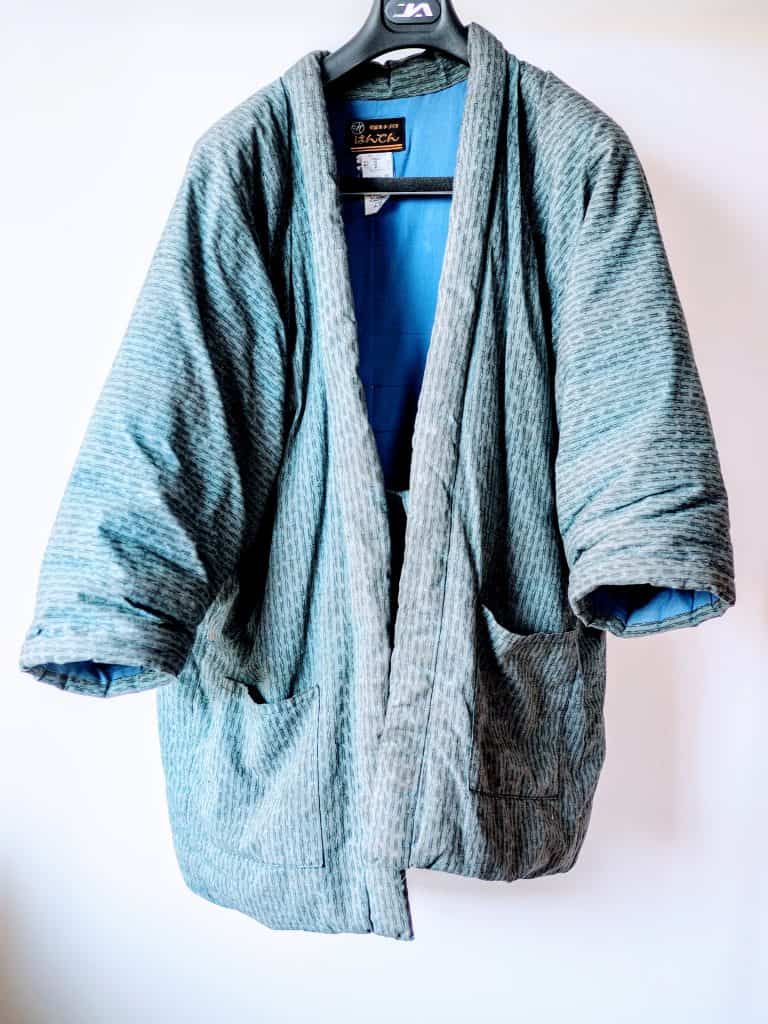
A Hanten is a type of Japanese jacket or vest. Hanten are commonly associated with thick winter Japanese jackets that are stuffed with cotton and most commonly worn as warm house-wear.
But other, lighter garments are also called hanten, and these are sometimes referred to by other names in the English speaking world, such as “Kimono shirts” or “Kimono wrap shirts”.
Hanten are strongly associated with being clothing of the everyday folk in Japan. Hanten stand in contrast to the Haori style jacket, which was traditionally worn by people of higher status.
The term “Hanten” is also used as a general term for a range of Japanese jackets, including the sub-type of “Happi”, which are thinner wrap around garments often worn at festivals, or as a kind of uniform.
Other names for hanten
The ambiguity that exists in naming of Japanese top garments found in hanten, haori and happi is further complicated by other words such as “Chanchanko”.
Well, as my partner once said to me, wearing a hanten is kind of like wearing a futon (in the Japanese sense of the word, meaning bedding). In the colder months, I literally wear my hanten jacket from morning to night, every day of the week. If it’s a cold night, I even wear it to bed – which is not uncommon in Japan. The Hanten is one versatile piece of clothing. It’s most closely associated with around-the-house wear in Japan, but you can also wear them out, or as pajamas. That’s a lot of bang for your buck.
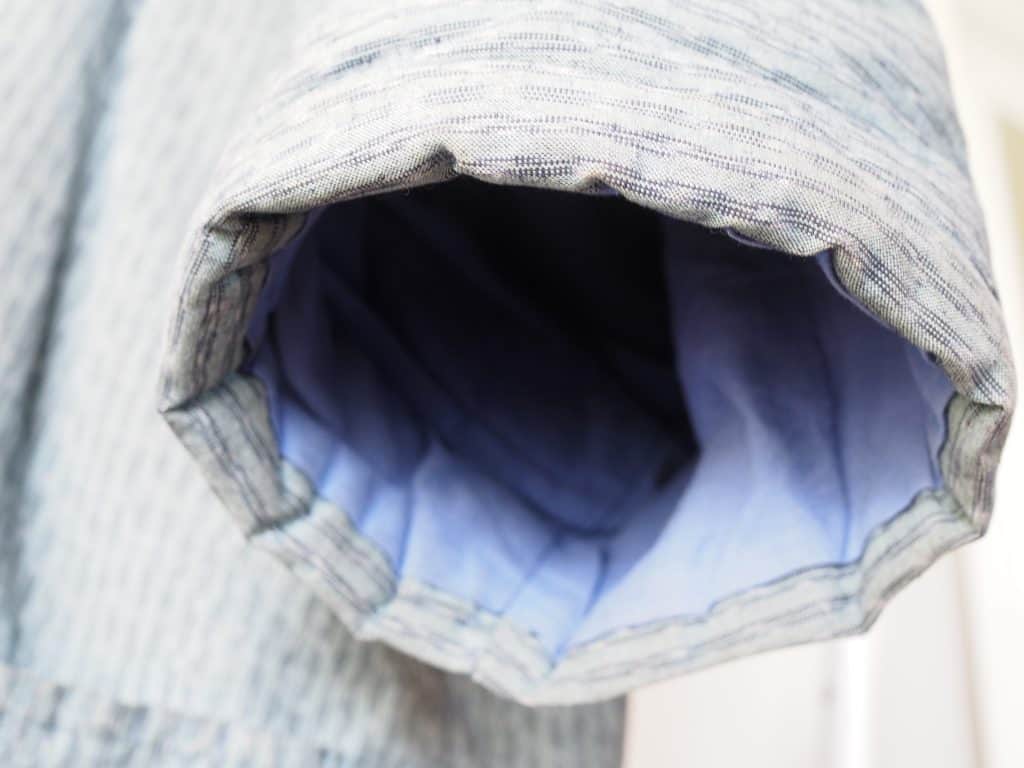
What is a chanchanko
“Chanchanko” is a term used to refer to a Japanese hanten jacket with short or no sleeves. It generally refers to the cotton-filled coat style of warm, winter hanten wrap around garments.
The term, though strictly referring to the short sleeve hanten, is often used for padded hanten of all shapes. This means there is some ambiguity in the term “chanchanko”‘s everyday use.
A traditional chanchanko usually looks something like this:
Types of Japanese Jackets - Hanten, Happi, Haori?
There is a lot of overlap between what gets called a hanten, a happi and a haori. This is true to some extent even in Japan, but you’ll find that in particular outside of Japan people tend to get, ahem, a little loosey goosey with the nomenclature (as is true with many Japanese objects).
Until the Edo period, a Happi was a Haori that was worn with a turned up collar and a Hanten was a garment that was worn to protect from the cold. In the Edo period, strict rules around which classes of people could wear types of clothing came into effect. Only people of high social standing could wear Haori, characterised by the folded up collar, while lower classes wore the non folded-collar hanten or happi. Hanten and haori also have differently shaped sleeves.
A haori is more commonly worn over the top of kimono, while hanten and happi are more commonly worn directly over underclothes or a shirt.
Adding to the confusion is the fact that a Happi can also be referred to as a Shirushi Banten (Banten being a slight variation on the word hanten, and shirushi meaning “symbol”). Confusing right? These Japanese jackets commonly have business symbols or insignias on them and can be seen at festivals and or festive business or shopping events.
What Types of Hanten Japanese Jackets are there?
There are three main lengths of winter-style hanten; long sleeve, mid length sleeve (Yakko) and sleeveless (Chanchanko).
Long Sleeve 長袖
Long sleeves are obviously the warmest option. If you are looking for something that is the closest to feeling like you are wrapped up in a blanket (without having to drag around a blanket with you), then this is the one.
The drawback is that cotton filled hanten Japanese jackets are very bulky. I find that I am constantly accidentally knocking things over when I wear them, and this is going to be most pronounced in a long sleeve Hanten. So if you think you are going to be wearing your hanten for anything work or task related, like cooking in the kitchen, or doing arts and craft, then this is probably not the best option. If you just want something to keep you warm when you’re lounging around watching the TV, this is the one.
Mid-Length Sleeve 半袖
The mid-length sleeve hanten has its own name, the “yakko”. This is the hanten / chanchanko I recommend for most people. You get most of the warmth of the long sleeve, and most of the utility of a sleeveless type in these mid-point hanten. That being said, I find even wearing the mid-length sleeve, I still inadvertently knock things off benches and surfaces from time to time due to the sheer bulk of the stuffed fabric hanten. But, generally speaking I still find it fine for cooking or doing most simple work-related tasks.
Short Sleeve 袖なし型(ちゃんちゃんこ)
The short sleeve hanten is popular for children, because they leave the hands free to get dirty. They are great for anyone that is looking for some extra body warmth while they are carrying out tasks with their hands, including cooking.
These Japanese vest chanchanko were very popular with Japanese people from the previous generation, so they are also considered quite nostalgic and associated with older people.
Now you’ve got all the info you need to embark on your quest for the perfect Jimbei. We’ve searched across the internet to find a selection across a range of outlets:
Where to buy a hanten?
There are several places that sell hanten Japanese jackets and Japanese vests online. Below are links to the hanten pages on the top major retailers.
Amazon
Etsy
Japan Store
Ali Express
We’ve got more general info about hanten construction below.
Recommended Men's Hanten
#2 Men's Hickory Hanten
This Hanten screams style and sophistication.
Pros
- Fine Quality Padded Cotton
- Beautiful 100% outer cotton fabric
- Standard Padding: 70% cotton, 30% polyester
Cons
- Non traditional colors
#3 Men's Super Colorful Watanosato Hanten
This hanten makes a STATEMENT!
Pros
- Well made.
- Reputable brand – Watanosato
- Standard Padding material mix: 70% Desi Cotton, 30% polyester
- Comfortable inner materials
Cons
- Two over the top for some!
#4 Patchwork Sugurajino Hanten
This design harks back to the “working class” nature of the hanten in beautiful way
Pros
- Unique patchwork design
- Quality fabric
- 90% cotton, 10% polyester
Cons
- Only one outside Pocket
#5 Men's Insignia Hanten
This one has a large Chinese Character on the back in the style of a “Montsuki ” 紋付きor “Shirushi Banten” 印半纏.
Pros
- Distinctive insignia design
- Classic understated blue
- Cotton Blend Materials
Cons
- Not Japanese made
Recommended Women's Hanten
#2 Women's Multi-Pattern Watanosato Hanten
This “patchwork kimono” style hanten is cute and feminine without being over the top.
Pros
- Tasteful patchwork patern
- All cotton outside
- Well padded and warm
- Quality workmanship
- Standard 70% cotton, 30% polyester padding inside
- Made in Japan
Cons
- Relatively short sleeves not as warm as longer sleeves (but better for doing work related tasks)
#3 Women's Reversible Watanosato Hanten
Why have just one lush pattern to wear when you could have two?
Pros
- Tasteful patchwork patern
- All cotton outside
- Well padded and warm
- Quality workmanship
- Standard 70% cotton, 30% polyester padding inside
- Made in Japan
Cons
- Relatively short sleeves not as warm as longer sleeves (but better for doing work related tasks)
#3 Sushi-Cat Print Hanten
It doesn’t get much cuter than a sushi-cat design pattern! Or much more iconically “Japanese” for that matter. Match the “cute” factor with the all-natural materials and this hanten is pretty attractive.
Pros
- Super-cute suhi-cat design
- Warm winter hanten coat
- 85% cotton 15% hemp outer.
- 70% cotton, 30% polyester padding inside
- Two pockets
- Made In Japan
Cons
- Long arm length can make it hard to do work based tasks.
- Too “cute” for some!
#4 Tropical Hanten
A sunny, tropical twist on the hanten with innovative design features such as inner pockets for placing heat packs.
Pros
- Unique tropical design
- Two inner pockets for putting “kairo” heat packs
- Polyester and Cotton materials.
Cons
- Not Japanese made
#5 Sleeveless Hanten Japanese Vest
If you want a hanten that keeps the body warm while leaving your arms free to move, unenumbered by the bulky cotton padding, this sleeveless hanten is a good option.
Pros
- Arms free to do work tasks such as cooking
- Plenty of padding/insulation = super warm
- Quality workmanship
- Standard 70% cotton, 30% polyester padding inside
- Two pockets
- Made In Japan
Cons
- No sleeve model not as warm as long sleeve
Recommended Kid's Hanten
#1 For Kid's - Cute Sugarajino Hanten
This is a classic traditional hanten from Watanosato, with striking rich colors.
Pros
- Plenty of padding/insulation = super warm
- Quality workmanship
- Standard 70% cotton, 30% polyester padding inside
- Two pockets
- non-slippery inside
- Made In Japan
Cons
- May be too traditional for some
#2 Kid's Spotted Hanten
Traditional Japanese spotted design for boys or girls
Pros
- Tasteful patchwork patern
- All cotton outside
- Well padded and warm
- Quality workmanship
- Standard 70% cotton, 30% polyester padding inside
- Made in Japan
Cons
- Relatively short sleeves not as warm as longer sleeves (but better for doing work related tasks)
#3 Kid's Soft Short Sleeve Hanten
100% cotton outside kids hanten with short sleeves to keep your toddler or young child warm
Pros
- 100% cotton
- Soft materials for sensitive kid’s skin
- Standard 70% cotton, 30% polyester padding inside
- Two pockets
- Short sleeves keep children’s hands free
Cons
- Only one color option
#4 Watanosato Traditional Children's Hanten
Natural outer material makes this hanten gentle on kid’s skin. This one is largely traditional and available in blue & red options.
Pros
- 100% Cotton outer
- Padded cotton/polyester padding
- Color options
- Very long sleeves keeps kids very warm!
Cons
- Long sleeves may get dirty in kids play
What are Hanten made of?
Most hanten are either made of cotton or a synthetic material such as polyester.
Cotton
Cotton is great for warmth and softness of touch. You will pay more for items made completely from natural materials though.
Synthetic Materials
Synthetic materials tend to allow more striking printed patterns. And polyester is cheaper. For the majority of hanten, you find that they will be a combination of cotton and polyester, with 70% cotton, 30% polyester being something of an industry standard.
Silk
Some very high end items are made of silk, but these are fairly uncommon. Silk is a material associated with wealth and opulence, and the hanten is considered a garment of the people, which probably explains while silk hanten are harder to find.
What does hanten mean in japanese?
The “han”半 from the word “hanten” means half, and refers to the length of the sleeves being half length. The “ten” 纏 simply refers to something that is worn.
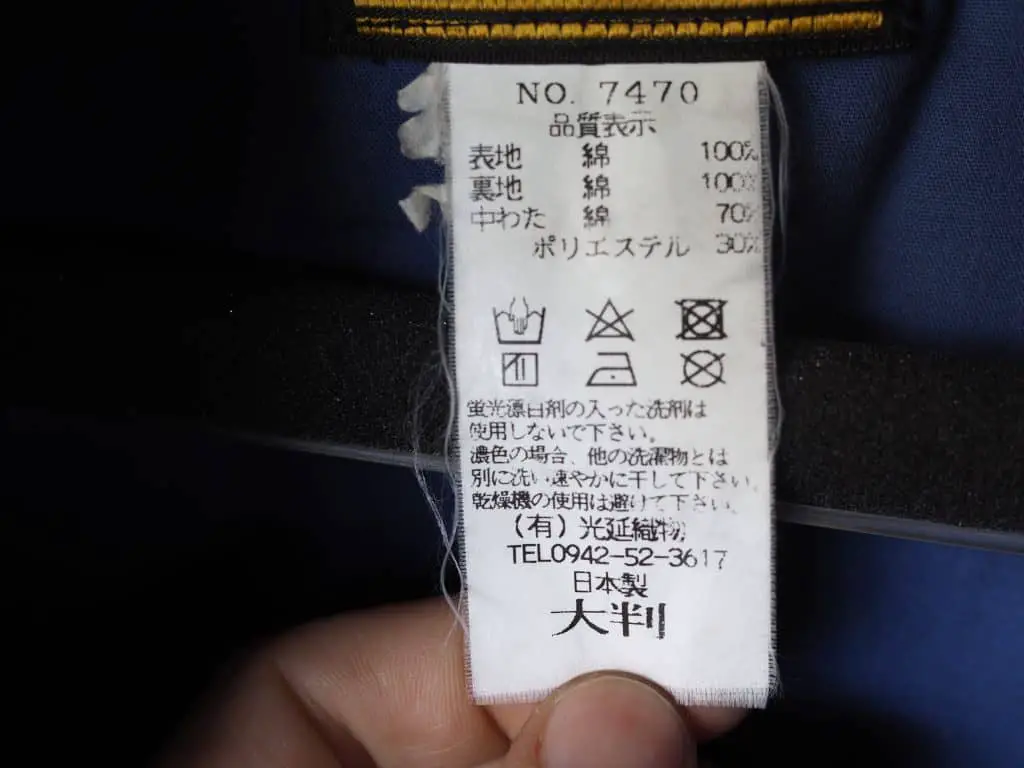
Reading The Tag
The tag above reads:
表地 Front Material 綿 Cotton 100%
裏地 Rear material 綿 Cotton 100%
中わた Inner Padding 綿 Cotton 70%
ポリエステル Polyester 30%
Who wears hanten in japan?
Hanten are worn widely by women, men and children. The hanten is considered a garment of the working classes, because of its history of being worn by people that were not considered high class enough to wear a haori.
In their unstuffed-with-cotton form, you’ll see them at festivals and with business names or other promotional writing written vertically down the inner hems.
In their stuffed-with-cotton form, they are basically worn by anyone who doesn’t like being a cold and doesn’t want to drag a doona around with them everywhere they go.
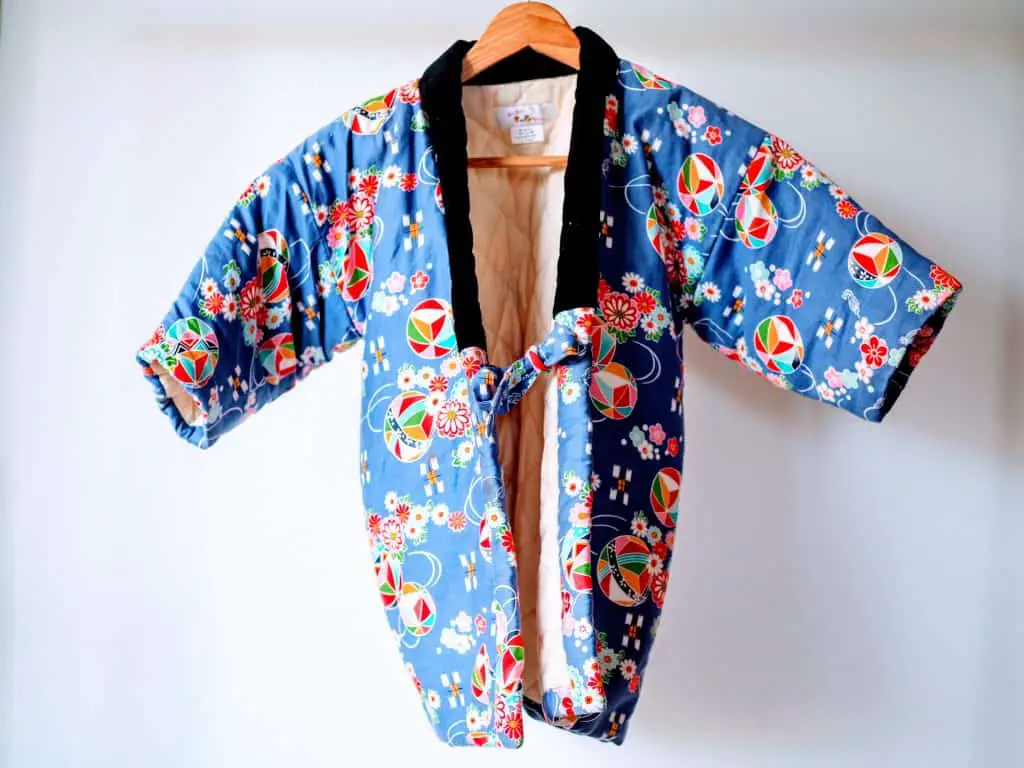
How to wear or coordinate a hanten jacket
A hanten can be worn over the top over most garments. They are large items that tie simply at the front with a short string, so they are flexible. In recent times, younger people in particular have been wearing hanten in combination with just about any kind of western clothing you can think of, so you don’t need to get caught up too much in looking for the “correct” way to coordinate. You can get a few ideas here.
You can even find hanten that are somewhere between a jacket and a traditional garment.
How to care for a hanten
Caring for a hanten is somewhat similar to caring for a futon – they need to be aired and dried out from time to time. Every one to two weeks it is best to find a sunny morning and hang them out in the light for an hour or two.
How to clean hanten
Generally speaking, hanten don’t take well to being washed in a machine. Depending on the garment, it may be possible to put your hanten in a net and machine wash. But you run the risk of having the padding inside the garment come out through the seams if the cycle is too rough. For most cases, it is better to wash by hand, smooth out any creases and let it dry out in the sun.
Hopefully this article has helped you figure out whether you need a hanten in your life! If you’re looking for something Japnese-inspired to wear in the summer months, check out our guide to the light and breezy Jinbei here.
Also check out Yokodana.com for a wide selection of Kimono related wear.
Japanoscope is a registered affiliate with several online shops and may receive a commission when you click on some of the links within content.
Other Japanese Products To Check Out
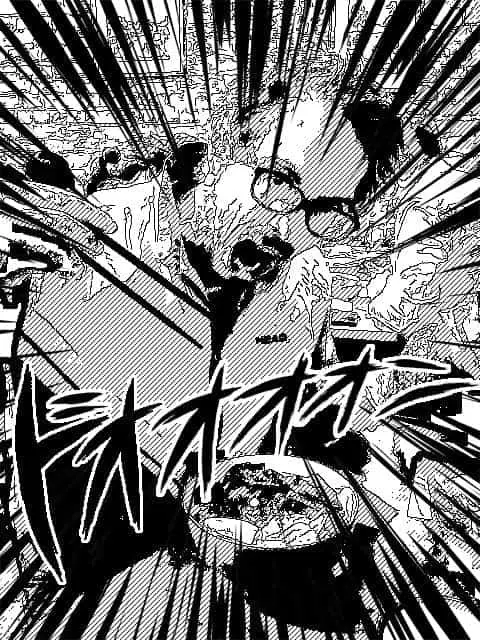
Contributor
Hi, I’m Peter. I lived in Japan for four years as a University student completing a Masters Degree in Musicology. I have succesfully completed the highest level of the Japanese Language Proficiency Test (N1). I have toured the country six times playing music and singing songs in Japanese and English.
